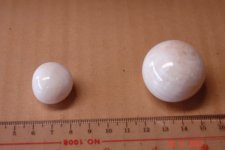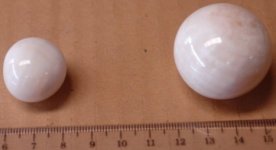Please make some general comment on the pearls from Tridacna. Is it considered rare? Does it fetch good market value? I've attach photos on the pearls for comments.
The ruler will give you an idea of the size. I don't have chance to get it certified from GIA yet as we don't have such service in our country. I might have to try and do that next time I travel overseas. The pearls are from the Pacific. I will let you guess which country and location.
By looking through the forum I don't see any posting on this type of pearl as well or maybe I'm wrong. That's why I'm posting this to hope and get some information. Also to share with people who are interested as well.
Note that my response might be slow but I will check and reply whenever possible.
I want to thank all the people who has contributed to this forum especially a few of those dedicated ones. I'm a new guy and I've learned a lot from the postings. I think people who openly shares their knowledge are the ones who will forever get better and be respected.
Thank you.
The ruler will give you an idea of the size. I don't have chance to get it certified from GIA yet as we don't have such service in our country. I might have to try and do that next time I travel overseas. The pearls are from the Pacific. I will let you guess which country and location.
By looking through the forum I don't see any posting on this type of pearl as well or maybe I'm wrong. That's why I'm posting this to hope and get some information. Also to share with people who are interested as well.
Note that my response might be slow but I will check and reply whenever possible.
I want to thank all the people who has contributed to this forum especially a few of those dedicated ones. I'm a new guy and I've learned a lot from the postings. I think people who openly shares their knowledge are the ones who will forever get better and be respected.
Thank you.




